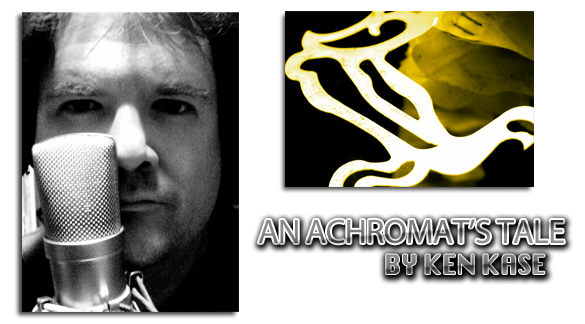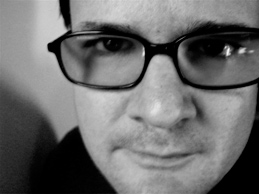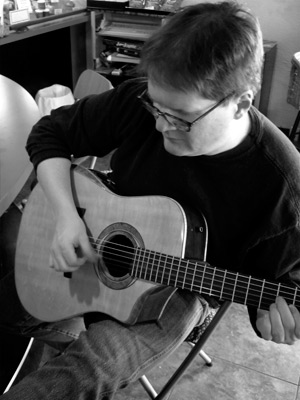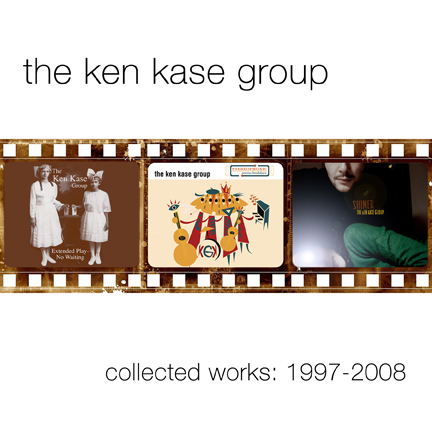
I am a musician and writer who lives in St. Louis. I was born in 1969 with a pronounced nystagmus that the doctors noticed just minutes after I was born. Initially, they thought I might have a tumor. My life has steadily improved since then.
The initial diagnosis was retinitis pigmentosa. I had never heard the word "achromatopsia" until 1997, when Oliver Sacks' book, Island of the Colorblind, written about people like me who live in Micronesia, was published. The list of symptoms--colorblindness, sensitivity to light, poor visual acuity--became a familiar litany when explaining my condition to others. I discovered that the word had been in my medical file since the 1970s, but no one told me that my condition had a name. As it turns out, I have severe rod monochromatism--no driving or practicing neurosurgery, but most things I want to do are fair game. I am the only achromat in my family.
familiar litany when explaining my condition to others. I discovered that the word had been in my medical file since the 1970s, but no one told me that my condition had a name. As it turns out, I have severe rod monochromatism--no driving or practicing neurosurgery, but most things I want to do are fair game. I am the only achromat in my family.
Having a child with a rare eye condition must have been daunting for my parents, but I wasn't unduly restricted or coddled. I was given the freedom to adapt and allowed to make my own mistakes, even if that meant walking into something and hurting myself. I was encouraged to get back up, learn from the experience and move on. I have tried to do just that ever since.
I was six months old when I got my first pair of prescription sunglasses. I imagine that I was probably more comfortable wearing them, but people could be harsh. Unaccustomed to seeing a six month old wearing ultra-dark sunglasses, people would sometimes berate my mother in public for allowing me to wear them, claiming that they would ruin my eyes. If they only knew.
One day shortly after I got them, I took them off my face and flung them into the parking lot of a department store, never to be seen again and soon replaced by another pair. Whether this was mere childish whim or a response to public opinion, I still don't know.
In kindergarten, I loved to color with crayons just like other kids. I remember sitting at round tables with a big box of crayons to share. The crayons at my table were your basic Crayolas with the names of the colors written on them. Although my concept of color is abstract, I did have a developing cultural understanding of what things were supposed to look like: The sky is blue. Grass is green. Apples are red. So I picked the appropriate crayons and did as I was asked.
 The result? Controversy. "Why, there's nothing wrong with him!” said the teachers. “All of the color choices he made are correct! He can see colors just fine!" My mother had to explain to them that I was reading the names of the colors and putting them in the right place. That's pretty normal coping behavior for those with achromatopsia, but folks found that difficult to comprehend in a five-year-old.
The result? Controversy. "Why, there's nothing wrong with him!” said the teachers. “All of the color choices he made are correct! He can see colors just fine!" My mother had to explain to them that I was reading the names of the colors and putting them in the right place. That's pretty normal coping behavior for those with achromatopsia, but folks found that difficult to comprehend in a five-year-old.
One day, they gave us crayons without the names of the colors written on them. My picture of the American flag just might have gotten me in trouble with the government. With its weird, clashing combinations of colors, it must have looked like a typical hideously decorated living room of the Seventies—a time when lack of color vision was considered an asset for interior decorators.
I entered first grade just after the Education for All Handicapped Children's Act of 1975 became law in the United States. This legislation mandated that children with disabilities should be taught in mainstream classrooms along with other students. Nowadays, people studying to be teachers have to take courses on how to teach children with disabilities. At the time there were no such requirements, so there was a fair amount of trial and error involved. Some teachers were willing to meet me halfway, some weren't. Some reached out, some didn't. I've found this average to be consistent with that of the real world.
I was sometimes penalized for being a bit too adaptable. I didn't use a cane or read Braille, but there were certain things I couldn't do. The lack of these “traditional” signs of a visual impairment made some of my teachers skeptical. I remember being accused of faking my disability by students and some teachers when being asked to perform detailed tasks in bright light or to work with colors. I spent some time in the "room down the hall" where the special education classes were so I could work one-on-one. That was helpful, but at the time, it also carried its own social stigma among peers and some teachers.
Using magnifiers, a small telescope and large print materials made me conspicuous, and that kind of attention made me uncomfortable. I disliked school because I had to endure a fair amount of mental and sometimes physical abuse from my classmates, but I did have a few friends for whom I was grateful. I was interested in music, so I had something to look forward to outside of school. I was a terrible student. Despite my high test scores and intelligence, my academic record was a disaster. But eventually, I went on to earn a B.A. and an M.A. in communication, graduating with distinction.
I use a pair of yellow tinted glasses for indoors and a pair of sporty-styled wraparound red tinted sunglasses to navigate the world outside. I find both pairs give me increased contrast that makes it easier to see. I also use a small telescope for reading street signs and a series of magnifiers for different tasks. I use screen enlargement software on my computer that helps tremendously with the audio recording and editing software I use every day. I find I get along quite well with my tools. Some people don't even know I have a visual impairment unless they see me using them. I used to feel a little self conscious about using them publicly, but now I just don't care.
Music has been a constant presence in my life. I'm a songwriter, performer and p roducer. I also write and record soundtrack and commercial music.
roducer. I also write and record soundtrack and commercial music.
Achromatopsia has had little influence on my ability to make music. I come from a family of musicians, so it's quite likely that I would have gone into music even with perfect vision.
As a songwriter, I had never considered addressing my condition in my work until 2000 when I wrote and released a song called "An Achromat's Tale". Looking back I can see how important it was for me to write it. The song expresses my philosophy of living with achromatopsia as something to be cherished--something that despite the challenges has given me my own view of the world and a special insight into the nature of perception and people. As an artist and as a human being, that perspective is priceless.
In 2011, I got a digital camera and started taking photographs. I just wanted to see what would happen and I was surprised and pleased by the results. I tend towards black and white, but some images just don’t look right to me unless they’re in color, although I can’t explain how or why. I concentrate on contrast, texture and composition—the very same attributes I use every day to navigate and survive. Taking pictures has given me just one more reason to embrace the unique perspective I have, with the added bonus of giving me a means of expression that conveys at least a semblance of how I see the world.
My eyes may be flawed, but I strive to see beyond my own experience. I try to understand the motivations of others rather than yearn to be understood. On that score, some days are better than others. I don't think anyone can fully understand achromatopsia any more than I can fully understand that there's a way of seeing the world other than the one I wake up to every morning. I try to be kind and patient when people ask me questions about it, bearing in mind that the condition is rare and people are naturally curious.
Our unwillingness to try to see through another's eyes is the root of misunderstanding among human beings and causes much misery in the world. My experience has helped me to understand that. Above all things, I refuse to let achromatopsia be the repository for life's shortcomings and dissatisfactions. It can be frustrating, maddening and inconvenient, but it has also given me an uncommon perspective that I would not have had otherwise. In the end, it's up to me to find my way.
To find out about my music and see my photos, please visit my website.



